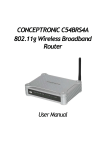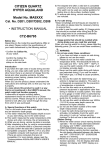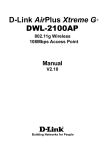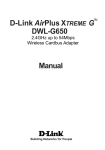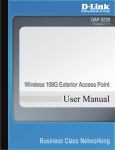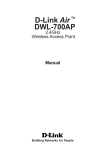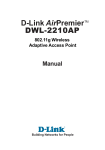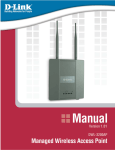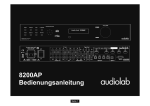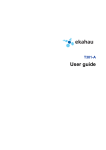Download D-Link DWL-8200AP User Manual 1
Transcript
D-Link DWL-8200AP User Manual 1 Table of Contents Product Overview......................................................... 4 Package Contents.................................................... 4 Minimum System Requirements............................... 4 Introduction............................................................... 5 Features & Benefits.................................................. 7 Wireless Basics........................................................ 8 Standards-based Technology................................... 9 Installation Considerations..................................... 10 Three Operational Modes....................................... 11 Installation................................................................... 12 Connecting PoE (Power over Ethernet)................. 14 Hardware Overview................................................ 15 Configuration.............................................................. 16 Logging In............................................................... 16 Home > Basic Settings > Wireless......................... 18 AP Mode > WEP Encryption................................... 20 AP Mode > WPA-Enterprise, WPA2-Enterprise & WPA-Auto Enterprise........................................ 21 AP Mode > WPA-Personal, WPA2-Personal & WPA-Auto Personal.......................................... 22 WDS with AP Mode .............................................. 23 WDS with AP Mode > WEP Encryption........... 25 WDS with AP Mode > WPA-Personal, WPA2Personal, WPA-Auto Personal.......................... 26 WDS Mode............................................................. 27 WDS Mode > WEP Encryption........................ 29 D-Link DWL-8200AP User Manual WDS Mode > WPA-Personal, WPA2-Personal, WPAAuto Personal................................................... 30 Home > Basic Settings > LAN ......................... 32 Home > Advanced Settings > Performance........... 33 Home > Advanced Settings > Grouping........... 36 Home > Advanced Settings > Multi-SSID......... 37 Home > Advanced Settings > Rogue AP.......... 40 DHCP Server > Dynamic Pool Settings........... 41 DHCP Server > Static Pool Settings................ 43 DHCP Server > Current IP List........................ 44 Filters >Wireless MAC ACL.............................. 46 Filters > WLAN Partition................................... 47 Home > Status > Device Information...................... 48 Client Information............................................. 49 WDS Information............................................. 50 Stats > WLAN 802.11a Statistics..................... 51 Ethernet Traffic Statistics.................................. 52 Stats > WLAN 802.11g Statistics...................... 53 Log > View Log................................................ 55 Log > Log Settings........................................... 56 Tool Menu............................................................... 57 Administrator Settings...................................... 58 Firmware and SSL Certification Upload........... 60 Configuration File Upload and Download........ 61 Configuration File > Upload.............................. 62 Tool > SNTP..................................................... 63 System > System Settings...................................... 64 2 Help........................................................................ 65 AP Manager II.............................................................. 66 Networking Basics..................................................... 67 Troubleshooting......................................................... 83 Technical Specifications........................................... 89 Contacting Technical Support.................................. 91 Warranty...................................................................... 92 Registration................................................................. 97 D-Link DWL-8200AP User Manual 3 Product Overview Package Contents D-Link Air Premier® DWL-8200AP Managed Dualband Access Point • Power over Ethernet base unit • Power Adapter-DC 48V, 0.4A • Power Cord • Manual and Warranty on CD • Install Guide • Ethernet Cable • Mounting Plate Note: Using a power supply with a different voltage than the one included with the DWL-8200AP will cause damage and void the warranty for this product. If any of the above items are missing, please contact your reseller. Minimum System Requirements • Computers with Windows®, Mac®, or Linux-based operating systems with an installed Ethernet Adapter • Internet Explorer version 7.0 or Firefox 3.0 and above • At least 128MB of memory and a 500MHz processor D-Link DWL-8200AP User Manual 4 Introduction At up to fifteen times the speed of previous wireless devices (maximum wireless signal rate of up to 108Mbps* in Super A and Super G mode), you can work faster and more efficiently, increasing productivity. With the DWL-8200AP, bandwidth-intensive applications like graphics or multimedia will benefit significantly because large files are able to move across the network quickly. Inclusion of all three standards (802.11a; 802.11b; 802.11g) means that the DWL-8200AP is versatile enough to allow connection to almost any 802.11 network or device. The DWL-8200AP is capable of operating in one of 3 different modes to meet your wireless networking needs. The DWL-8200AP can operate as an access point, or in WDS (Wireless Distribution System) with AP, or in WDS mode. Use less wiring, enjoy increased flexibility, save time and money with PoE (Power over Ethernet). With PoE, the DWL-8200AP shares power and data over the CAT5 cable, making the setup of your network less expensive and more convenient. An ideal solution for quickly creating and extending a wireless local area network (WLAN) in offices or other workplaces, trade shows and special events, the DWL-8200AP provides data transfers at up to 108Mbps* in Super A and Super G mode when used with other D-Link Air Premier® or Air Premier AG® products (The 802.11g standard is backwards compatible with 802.11b devices). WPA is offered in two flavors: Enterprise (used for corporations), and Personal (used for home users). WPA-Personal and WPA2-Personal is directed at home users who do not have the server based equipment required for user authentication. The method of authentication is similar to WEP because you define a “Pre-Shared Key” on the wireless router/AP. Once the pre-shared key is confirmed and satisfied on both the client and access point, then access is granted. The encryption method used is referred to as the Temporal Key Integrity Protocol (TKIP), which offers per-packet dynamic hashing. It also includes an integrity checking feature which ensures that the packets were not tampered with during wireless transmission. WPA2-Personal is far superior to WPA-Personal, because the encryption of data is upgraded with the Advanced Encryption Standard (AES). *Maximum wireless signal rate derived from IEEE Standard 802.11a and 802.11g specifications. Actual data throughput will vary. Network conditions and environmental factors, including volume of network traffic, building materials and construction, and network overhead lower actual data throughput rate. D-Link DWL-8200AP User Manual 5 WPA-Enterprise and WPA2-Enterprise is ideal for businesses that have existing security infrastructures in place. Management and security implementation can now be centralized on a server participating on the network. Utilizing 802.1x with a RADIUS (Remote Authentication Dial-in User Service) server, a network administrator can define a list of authorized users who can access the wireless LAN. When attempting to access a wireless LAN with either WPA-Enterprise or WPA2-Enterprise configured, the new client will be challenged with a username and password. If the new client is authorized by the administration, and enters the correct username and password, then access is granted. In a scenario where an employee leaves the company, the network administrator can remove the employee from the authorized list and not have to worry about the network being compromised by a former employee. WPA2-Enterprise is far superior to WPA-Enterprise, because the encryption of data is upgraded with the Advanced Encryption Standard (AES). 802.1x: Authentication which is a first line of defense against intrusion. In the authentication process, the Authentication Server verifies the identity of the client attempting to connect to the network. Unfamiliar clients would be denied access. D-Link DWL-8200AP User Manual 6 Features & Benefits • 3 Different Operation modes - Capable of operating in one of three different operation modes to meet your wireless networking requirements: Access Point; WDS with AP; or WDS. • Easy Installation with PoE (Power over Ethernet). • Faster wireless networking speeds up to 108Mbps* in Super A and Super G mode. • Compatible with 802.11a, 802.11b and 802.11g Devices that is fully compatible with the IEEE 802.11a, 802.11b and 802.11g standards, the DWL-8200AP can connect with existing 802.11b-, 802.11g- or 802.11a-compliant wireless network adapter cards. • Compatible with the 802.11b standard to provide a wireless data rate of up to 11Mbps - that means you can migrate your system to the 802.11g standard on your own schedule without sacrificing connectivity. • Better security with WPA - The DWL-8200AP can securely connect wireless clients on the network using WPA (Wi-Fi Protected Access) providing a much higher level of security for your data and communications than has previously been available. • SNMP for Management - The DWL-8200AP is not just fast but it also supports SNMP v.3 for a better network management. Superior wireless AP manager software is bundled with the DWL-8200AP for network configuration and firmware upgrade. Systems administrators can also setup the DWL-8200AP easily with the Web-based configuration. A D-Link D-View module will be downloadable for network administration and real-time network traffic monitoring with D-Link D-View software. • Utilizes OFDM technology (Orthogonal Frequency Division Multiplexing). • Operates in the 2.4GHz frequency range for an 802.11b/g network, and in the 5GHz frequency range for an 802.11a network. • Web-based interface for managing and configuring. *Maximum wireless signal rate derived from IEEE Standard 802.11a and 802.11g specifications. Actual data throughput will vary. Network conditions and environmental factors, including volume of network traffic, building materials and construction, and network overhead lower actual data throughput rate. D-Link DWL-8200AP User Manual 7 Wireless Basics D-Linkwireless products are based on industry standards to provide easy-to-use and compatible high-speed wireless connectivity within your home, business or public access wireless networks. D-Link wireless products will allow you to access the data you want, when and where you want it. You will be able to enjoy the freedom that wireless networking brings. A Wireless Local Area Network (WLAN) is a computer network that transmits and receives data with radio signals instead of wires. WLANs are used increasingly in both home and office environments, and public areas such as airports, coffee shops and universities. Innovative ways to utilize WLAN technology are helping people to work and communicate more efficiently. Increased mobility and the absence of cabling and other fixed infrastructure have proven to be beneficial for many users. Mobility - Productivity increases when people have access to data in any location within the operating range of the WLAN. Management decisions based on real-time information can significantly improve worker efficiency. Low Implementation Costs - WLANs are easy to set up, manage, change and relocate. Networks that frequently change can benefit from WLANs ease of implementation. WLANs can operate in locations where installation of wiring may be impractical. Installation and Network Expansion - Installing a WLAN system can be fast and easy and can eliminate the need to pull cable through walls and ceilings. Wireless technology allows the network to go where wires cannot go - even outside the home or office. Inexpensive Solution - Wireless network devices are as competitively priced as conventional Ethernet network devices. The DWL-8200AP saves money by providing multi-functionality, configurable in one of three different modes. Scalability - WLANs can be configured in a variety of ways to meet the needs of specific applications and installations. Configurations are easily changed and range from Peer-to-Peer networks suitable for a small number of users to larger Infrastructure networks to accommodate hundreds or thousands of users, depending on the number of wireless devices deployed. D-Link DWL-8200AP User Manual 8 Standards-based Technology The DWL-8200AP Wireless Access Point utilizes the 802.11a, 802.11b and the 802.11g standards. The IEEE 802.11g standard is an extension of the 802.11b standard. It increases the maximum wireless signal rate of up to 54Mbps* (maximum wireless signal rate of up to 108Mbps* in Super G mode) within the 2.4GHz band, utilizing OFDM technology. This means that in most environments, within the specified range of this device, you will be able to transfer large files quickly or even watch a movie in MPEG format over your network without noticeable delays. This technology works by transmitting high-speed digital data over a radio wave utilizing OFDM (Orthogonal Frequency Division Multiplexing) technology. OFDM works by splitting the radio signal into multiple smaller sub-signals that are then transmitted simultaneously at different frequencies to the receiver. OFDM reduces the amount of crosstalk (interference) in signal transmissions. The D-Link DWL-8200AP will automatically sense the best possible connection speed to ensure the greatest speed and range possible. The DWL-8200AP offers the most advanced network security features available today, including WPA and WPA2. In addition to its compatibility with 802.11g and 802.11a devices, the DWL-8200AP is compatible with 802.11b devices. This means that if you have an existing 802.11b network, or a network with a mixture of 802.11g, 802.11a and 802.11b, the devices in that network will be compatible with the DWL-8200AP. *Maximum wireless signal rate derived from IEEE Standard 802.11a and 802.11g specifications. Actual data throughput will vary. Network conditions and environmental factors, including volume of network traffic, building materials and construction, and network overhead lower actual data throughput rate. D-Link DWL-8200AP User Manual 9 Installation Considerations The D-Link Air Premier® DWL-8200AP lets you access your network, using a wireless connection, from virtually anywhere within its operating range. Keep in mind, however, that the number, thickness and location of walls, ceilings, or other objects that the wireless signals must pass through, may limit the range. Typical ranges vary depending on the types of materials and background RF (radio frequency) noise in your home or business. The key to maximizing wireless range is to follow these basic guidelines: 1. Keep the number of walls and ceilings between the DWL-8200AP and other network devices to a minimum - each wall or ceiling can reduce your DWL-8200AP’s range from 3-90 feet (1-30 meters.) Position your devices so that the number of walls or ceilings is minimized. 2. Be aware of the direct line between network devices. A wall that is 1.5 feet thick (.5 meters), at a 45-degree angle appears to be almost 3 feet (1 meter) thick. At a 2-degree angle it looks over 42 feet (14 meters) thick! Position devices so that the signal will travel straight through a wall or ceiling (instead of at an angle) for better reception. 3. Building materials can impede the wireless signal - a solid metal door or aluminum studs may have a negative effect on range. Try to position wireless devices and computers with wireless adapters so that the signal passes through drywall or open doorways and not other materials. 4. Keep your product away (at least 3-6 feet or 1-2 meters) from electrical devices or appliances that generate RF noise. D-Link DWL-8200AP User Manual 10 Three Operational Modes Operation Mode Access Point (AP) WDS with AP WDS D-Link DWL-8200AP User Manual Function Create a wireless LAN (WLAN) Wirelessly connect multiple networks while still functioning as an access point. Wirelessly connect multiple networks. 11 Installation D-Link DWL-8200AP User Manual 12 1. You will need broadband Internet access. 2. Consult with your Cable or DSL provider for proper installation of the modem. 3. Connect the Cable or DSL modem to a Router. () 4. Connect the Ethernet Broadband Router to the PoE base unit. (DWL-8200AP) 5. Connect the DWL-8200AP to the PoE base unit. (DWL-8200AP) 6. If you are connecting a desktop computer to your network, install the D-Link DWL-AG530 wireless PCI adapter into an available PCI slot on your desktop computer.7. Install the drivers for the D-Link DWL-AG660 wireless Cardbus adapter into a laptop computer. () D-Link DWL-8200AP User Manual 13 Connecting PoE (Power over Ethernet) Step 1 Connect one end of an Ethernet cable (included with your package) to the LAN port on the DWL-8200AP and the other end of the Ethernet cable to the port labeled P+DATA OUT on the PoE base unit. Step 2 Connect another Ethernet cable from the DATA IN port on the PoE base unit to your router/switch or to a PC. Step 3 Attach the power adapter to the connector on the PoE base unit. Attach the power cord to the power adapter and into an electrical outlet. D-Link DWL-8200AP User Manual 14 Hardware Overview Antennas Power Cord LAN 1 (PoE) D-Link DWL-8200AP User Manual LAN 2 Reset 15 Configuration To configure the DWL-8200AP, use a computer which is connected to the DWL-8200AP with an Ethernet cable (see the Network Layout diagram). First, disable the Access the Internet using a proxy server function. To disable this function, go to Control Panel > Internet Options > Connections > LAN Settings and un-check the enable box. Logging In Start your web browser program (Internet Explorer, Firefox). Type the IP address of the DWL-8200AP in the address field (http://192.168.0.50) and press Enter. Make sure that the IP addresses of the DWL-8200AP and your computer are in the same subnet. DWL-8200AP also supports HTTPS Browsing by using the Secure Socket Layer (SSL) Protocol. Just change your Browser’s address line from “http://...” to “https://...” and log into the AP again. After the connection is established, you will see the user identification window as shown. Note: If you have changed the default IP address assigned to the DWL-8200AP, make sure to enter the correct IP address. D-Link DWL-8200AP User Manual 16 After successfully logging into the DWL-8200AP the following screen appears: When making changes on most of the configuration screens in this section, use the Apply button at the bottom of each screen to save your configuration changes. Click to Apply configuration changes. D-Link DWL-8200AP User Manual 17 Home > Basic Settings > Wireless Wireless Band: Select either IEEE 802.11a or IEEE 802.11g Mode: Access Point is selected from the pull-down menu. SSID: Service Set Identifier (SSID) is the name designated for a specific wireless local area network (WLAN). The SSID’s factory default setting is dlink. The SSID can be easily changed to connect to an existing wireless network or to establish a new wireless network. SSID Broadcast: Enable or Disable SSID broadcast. Enabling this feature broadcasts the SSID across the network. Channel: Displays the default channel for the wireless network. All devices on the network must share the same channel. The channel of an 802.11a network may not be set manually in certain regions (e.g. Europe and USA) in order to comply with DFS (Dynamic Frequency Selection). D-Link DWL-8200AP User Manual 18 Note: The wireless adapters will automatically scan and match the wireless setting. Auto Channel Select Enable or Disable. Enable this feature to auto-select the channel for best wireless performance. To comply with Scan: DFS (Dynamic Frequency Selection), this function is not available to use in certain regions (e.g. Europe). Authentication: Select Open System to communicate the key across the network. Select Shared Key to limit communication to only those devices that share the same WEP settings. Select Open System/Shared Key to allow either form of data encryption. Select WPA-Enterprise to secure your network with the inclusion of a RADIUS server. Select WPA-Personal to secure your network using a password and dynamic key changes. (No RADIUS server required.) Select WPA2-Enterprise to secure your network with the inclusion of a RADIUS server and upgrade the encryption of data with the Advanced Encryption Standard (AES). Select WPA2-Personal to secure your network using a password and dynamic key changes. No RADIUS server required and encryption of data is upgraded with the Advanced Encryption Standard (AES). Select WPA-Auto-Enterprise to allow the client to either use WPA-Enterprise or WPA2-Enterprise. Select WPA-Auto-Enterprise to allow the client to either use WPA-Personal or WPA2-Personal. Radio: Select On or Off. Selecting Off will turn off all wireless functions. D-Link DWL-8200AP User Manual 19 AP Mode > WEP Encryption Encryption: Select Disabled or Enabled. Key Type: Select HEX or ASCII. Key Size: Select 64-bit, 128-bit, or 152 bits. Valid Key: Select the 1st through the 4th key to be the active key. First through Input up to four keys for encryption. You will select one of these keys in the valid key field. Fourth keys: * Hexadecimal digits consist of the numbers 0-9 and the letters A-F. ASCII (American Standard Code for Information Interchange) is a code for representing English letters as numbers 0-127. D-Link DWL-8200AP User Manual 20 AP Mode > WPA-Enterprise, WPA2-Enterprise & WPA-Auto Enterprise Cipher Type: When you select WPA-Enterprise, you must select AUTO, AES, or TKIP from the pull down menu. Group Key Select the interval during which the group key will be valid. Update Interval: 1800 is the recommended value. A lower interval may reduce data transfer rate. RADIUS Server: Enter the IP address of the RADIUS server. RADIUS Port: RADIUS Secret: Enter the RADIUS port. Enter the RADIUS secret. Accounting Select if you want to use a different server for accountMode: ing. Accounting Enter the IP address of the Accounting server. Server: Accounting Port: Enter the Accounting port (1813 is default). Note: You may input the secondary RADIUS server and Accounting server settings if you have a backup RADIUS and Accounting server. D-Link DWL-8200AP User Manual 21 AP Mode > WPA-Personal, WPA2-Personal & WPA-Auto Personal Cipher Type: When you select WPA-Personal, WPA2-Personal, or WPA-Auto-Personal, you must select AUTO, AES, or TKIP from the pull-down menu. Group Key Update Select the interval during which the group key will be valid. The default value of 1800 is recommended. Interval: PassPhrase: When you select WPA-Personal, WPA2-Personal, or WPA-Auto-Personal, please enter a PassPhrase in the corresponding field. D-Link DWL-8200AP User Manual 22 WDS with AP Mode In WDS with AP mode, the DWL-8200AP wirelessly connects multiple networks, while still functioning as a wireless AP. Wireless Band: Select either IEEE 802.11a or IEEE 802.11g Mode: WDS with AP is selected from the pull-down menu. SSID: Service Set Identifier (SSID) is the name designated for a specific wireless local area network (WLAN). The SSID’s factory default setting is dlink. The SSID can be easily changed to connect to an existing wireless network or to establish a new wireless network. D-Link DWL-8200AP User Manual 23 SSID Broadcast: Enable or Disable SSID broadcast. Enabling this feature broadcasts the SSID across the network. Channel: Displays the default channel for the wireless network. All devices on the network must share the same channel. The channel of an 802.11a network may not be set manually in certain regions (e.g. Europe and USA) in order to comply with DFS (Dynamic Frequency Selection). Note: The wireless adapters will automatically scan and match the wireless setting. Auto Channel Scan: This option is unavailable in WDS with AP mode. Remote AP MAC Enter the MAC addresses of the APs in your network that will serve as bridges to wirelessly connect multiple networks. Address: WDS Site Survey: Click on the Scan button to search for available wireless networks. Click on the network you want to connect to. Authentication: Select Open System to communicate the key across the network. Select Shared Key to limit communication to only those devices that share the same WEP settings. Select Open System/Shared Key to allow either form of data encryption. Select WPA-Personal to secure your network using a password and dynamic key changes. (No RADIUS server required.) Select WPA2-Personal to secure your network using a password and dynamic key changes. No RADIUS server required and encryption of data is upgraded with the Advanced Encryption Standard (AES). Select WPA-Auto-Personal to allow the client to either use WPA-Personal or WPA2-Personal. D-Link DWL-8200AP User Manual 24 WDS with AP Mode > WEP Encryption Encryption: Select Disabled or Enabled. Key Type: Select HEX or ASCII. Key Size: Select 64-bit, 128-bit, or 152 bits. Valid Key: Select the 1st through the 4th key to be the active key. First through Input up to four keys for encryption. You will select Fourth keys: one of these keys in the valid key field. * Hexadecimal digits consist of the numbers 0-9 and the letters A-F. ASCII (American Standard Code for Information Interchange) is a code for representing English letters as numbers 0-127. D-Link DWL-8200AP User Manual 25 WDS with AP Mode > WPA-Personal, WPA2-Personal, WPA-Auto Personal Cipher Type: When you select WPA-Personal, WPA2-Personal, or WPA-Auto-Personal you must select AUTO or AES from the pull-down menu. Group Key Update Select the interval during which the group key will be Interval: valid. The default value of 1800 is recommended. PassPhrase: When you select WPA-Personal, WPA2-Personal, or WPA-Auto-Personal please enter a PassPhrase in the corresponding field. D-Link DWL-8200AP User Manual 26 WDS Mode In WDS, the DWL-8200AP wirelessly connects multiple networks, without functioning as a wireless AP. Wireless Band: Select either IEEE 802.11a or IEEE 802.11g Mode: WDS is selected from the pull-down menu. SSID: Service Set Identifier (SSID) is the name designated for a specific wireless local area network (WLAN). The SSID’s factory default setting is dlink. The SSID can be easily changed to connect to an existing wireless network or to establish a new wireless network. SSID Broadcast: Enable or Disable SSID broadcast. Enabling this feature broadcasts the SSID across the network. Channel: Displays the default channel for the wireless network. All devices on the network must share the same channel. The channel of an 802.11a network may not be set manually in certain regions (e.g. Europe and USA) in order to comply with DFS (Dynamic Frequency Selection). Auto Channel This option is unavailable in WDS mode. Scan: Remote AP MAC Enter the MAC addresses of the APs in your network Address: that will serve as bridges to wirelessly connect D-Link DWL-8200AP User Manual 27 WDS Site multiple networks. Survey: Click on the Scan button to search for available wireless networks. Click on the network you want to connect to. Authentication: Select Open System to communicate the key across the network. Select Shared Key to limit communication to only those devices that share the same WEP settings. Select Open System/Shared Key to allow either form of data encryption. Select WPA-Personal to secure your network using a password and dynamic key changes. (No RADIUS server required.) Select WPA2-Personal to secure your network using a password and dynamic key changes. No RADIUS server required and encryption of data is upgraded with the Advanced Encryption Standard (AES). Select WPA-Auto-Personal to allow the client to either use WPA-Personal or WPA2-Personal. D-Link DWL-8200AP User Manual 28 WDS Mode > WEP Encryption Encryption: Select Disabled or Enabled. (Disabled is selected here). Key Type: Select HEX or ASCII. Key Size: Select 64-bit, 128-bit, or 152 bits. Valid Key: Select the 1st through the 4th key to be the active key. First through Input up to four keys for encryption. You will select one of these keys in the valid key field. Fourth keys: * Hexadecimal digits consist of the numbers 0-9 and the letters A-F. ASCII (American Standard Code for Information Interchange) is a code for representing English letters as numbers 0-127. D-Link DWL-8200AP User Manual 29 WDS Mode > WPA-Personal, WPA2-Personal, WPA-Auto Personal Cipher Type: AES is selected. Group Key Update Select the interval during which the group key will be valid. The default value of 1800 is recommended. Interval: PassPhrase: When you select WPA-Personal, WPA2-Personal, or WPA-Auto-Personal, please enter a PassPhrase in the corresponding field. D-Link DWL-8200AP User Manual 30 Mode Authentication Available Access Point Open System Shared Key Open System/Shared Key WPA-Enterprise WPA-Personal WPA2-Enterprise WPA2-Personal WPA-Auto-Enterprise WPA-Auto-Personal WDS with AP Open System Shared Key Open System/Shared Key WPA-Personal WPA2-Personal WPA-Auto-Personal WDS Open System Shared Key Open System/Shared Key WPA-Personal WPA2-Personal WPA-Auto-Personal D-Link DWL-8200AP User Manual 31 Home > Basic Settings > LAN LAN is short for Local Area Network. This is considered your internal network. These are the IP settings of the LAN interface for the DWL-8200AP. These settings may be referred to as private settings. You may change the LAN IP address if needed. The LAN IP address is private to your internal network and cannot be seen on the Internet. Get IP From: Static (Manual) is chosen here. Choose this option if you do not have a DHCP server in your network, or if you wish to assign a static IP address to the DWL-8200AP. When Dynamic (DHCP) is selected the other fields here will be greyed out. IP Address: The default IP address is 192.168.0.50. Assign a static IP address that is within the IP address range of your network. Subnet Mask: Enter the subnet mask. All devices in the network must share the same subnet mask. Default Gateway: Enter the IP address of the gateway in your network. If there isn’t a gateway in your network, please enter an IP address within the range of your network. D-Link DWL-8200AP User Manual 32 Home > Advanced Settings > Performance By changing radio parameters in the performance section, you can customize the radio network to fit your needs. Performance functions are designed for more advanced users who are familiar with 802.11 wireless networks and radio configuration. Wireless Band: Select IEEE 802.11a or IEEE 802.11g from this pull-down menu. Frequency: Displays the current frequency for the wireless network. The frequency reflects the choice of the wireless band. Channel: Indicates the channel setting for the DWL-8200AP. The channel can be changed to fit the channel setting for an existing wireless network or to customize the wireless network. The channel of an 802.11a network may not be set manually in certain regions (e.g. Europe and USA) in order to comply with DFS (Dynamic Frequency Selection). D-Link DWL-8200AP User Manual 33 Data Rate*: The default value is set to “Auto”, which adjusts the base transfer rate depending on the base rate of the connecting device. The Data Rates are Auto, 6Mbps, 9Mbps, 12Mbps, 18Mbps, 24Mbps, 36Mbps, 48Mbps, 54Mbps. Beacon Interval Beacons are packets sent by an Access Point to synchronize a wireless network. Specify a Beacon interval value (20-1000): between 20 and 1000. The default value is set to 100 milliseconds. DTIM (1-255): (Delivery Traffic Indication Message) - Select a setting between 1 and 255. 1 is the default setting. DTIM is a countdown informing clients of the next window for listening to broadcast and multicast messages. Fragmentation The fragmentation threshold, which is specified in bytes, determines whether packets will be fragmented. Packets Length (256-2346): exceeding the 2346 byte setting will be fragmented before transmission. 2346 is the default setting. RTS Length This value should remain at its default setting of 2346. If you encounter inconsistent data flow, only minor (256-2346): modifications to the value range between 256 and 2346 are recommended. Transmit Power: Choose full, half (-3dB), quarter (-6dB), eighth (-9dB), minimum power. Super Mode: Super Mode is a group of performance enhancement features that increase end user application throughput in an 802.11a and 802.11g network. Super Mode is backwards compatible to standard 802.11g devices. For top performance, all wireless devices on the network should be Super Mode capable. Select either Disabled, Super Mode without Turbo, Super Mode with Static Turbo, or Super Mode with Dynamic Turbo. Disabled: Standard 802.11a and 802.11g support, no enhanced capabilities. *Maximum wireless signal rate derived from IEEE Standard 802.11a and 802.11g specifications. Actual data throughput will vary. Network conditions and environmental factors, including volume of network traffic, building materials and construction, and network overhead lower actual data throughput rate. D-Link DWL-8200AP User Manual 34 Super Mode Capable of Packet Bursting, FastFrames, Compression, and no Turbo mode. without Turbo: Super Mode Capable of Packet Bursting, FastFrames, Compression, and Static Turbo. This setting is not backwards with Static compatible with non-Turbo (legacy) devices. Static turbo mode is always on and is only enabled when Turbo: all the devices on the wireless network are configured with Super Mode with Static Turbo enabled. Note: Super Mode with Static Turbo is only available for 802.11a. Super Mode Capable of Packet Bursting, FastFrames, Compression, and Dynamic Turbo. This setting is backwards with Dynamic compatible with non-Turbo (legacy) devices. Dynamic Turbo Mode is only enabled when all Turbo: devices on the wireless network are configured with Super Mode with Dynamic Turbo enabled. WMM: (Wi-Fi Multimedia) Improves the user experience for audio, video, and voice applications over a Wi-Fi network. WMM is based on a subset of the IEEE 802.11e WLAN QoS standard. Preamble The Preamble Type defines the length of the CRC (Cyclic Redundancy Check) block for communication between the (802.11g only): Access Point and roaming wireless adapters. The default setting is set to “Short and long” Preamble. Note: High network traffic areas should use the shorter preamble type. CRC is a common technique for detecting data transmission errors. Wireless B/G This function allows you to configure the wireless network with IEEE 802.11g only, IEEE 802.11b only, or IEEE Mode 802.11g with backward interoperability with IEEE 802.11. (802.11g only): Antenna This option is enabled by default. When enabled, each radio (5GHz/2.4GHz) will automatically switch to the antenna Diversity: with the greatest RSSI value. When disabled, each radio will use its main antenna - when facing the AP, 5GHz will use the right antenna to transmit and receive packets while the 2.4GHz radio will use the left. Data Rate If you select enable, you will be able to set the AP to transmit only certain data rates. Control: D-Link DWL-8200AP User Manual 35 Home > Advanced Settings > Grouping Load Balance: When Enabled, you allow several DWL-8200APs to balance wireless network traffic and wireless clients among DWL-8200APs in the network. Assign each access point a different non-overlapping channel (e.g., 1, 6, 11). User Limit (0-64): Set the User Limit in this field (0-64). D-Link DWL-8200AP User Manual 36 Home > Advanced Settings > Multi-SSID Enable Multi-SSID: When Multi-SSID is enabled, you can configure your SSIDs for either both, 11a only, or 11g only networks. Enable VLAN Check to use a VLAN. Status: Enable Priority: Allows you to prioritize per SSID. Band: Select the wireless band (IEEE802.11a or IEEE802.11g). Index: You can select up to 7 multi-SSIDs per band, the default multi-SSIDs is the primary, which puts the total to 8 multi-SSIDs per band. SSID: Service Set Identifier (SSID) is the name designated for a specific wireless local area network (WLAN). The SSID’s factory default setting is dlink. The SSID can be easily changed to connect to an existing wireless network or to establish a new wireless network. SSID Broadcast: Select Disable to prevent the SSID name to be broadcast. D-Link DWL-8200AP User Manual 37 Security: The Multi-SSIDs security can be WPA/WPA2-Enterprise or WPA-Auto-Enterprise only when the Primary SSID’s security is at the same security level. Also, they must connect to the same RADIUS server. Ethernet: Select “LAN1” if you wish to configure the network on LAN 1 (PoE). Select “LAN2” to set up the network on LAN 2. VLAN ID: Enter the VLAN ID you want to use (0 - 4094) Key Type: Select HEX or ASCII. Key Size: Select 64-bit, 128-bit, or 152-bit. Key: Select the 1st key all the way through the 4th key, to be set as the active key. Enter key here. When Primary SSID is set to any of the following security levels: None Open System (WEP) Shared Key (WEP) WPA-Personal WPA2-Personal WPA-Auto-Personal WPA-Enterprise WPA2-Enterprise WPA-Auto-Enterprise D-Link DWL-8200AP User Manual Multi-SSID can use any of these security levels: None Open System (WEP) Shared Key (WEP) WPA-Personal WPA2-Personal WPA-Auto-Personal None Open System (WEP) Shared Key (WEP) WPA-Personal WPA2-Personal WPA-Auto-Personal WPA-Enterprise WPA2-Enterprise WPA-Auto-Enterprise 38 Cipher Type: When you select WPA-Personal, please select AUTO, AES, or TKIP from the pull down menu. Group Key Update Select the interval during which the group key will be valid. The default value of 1800 is recommended. Interval: PassPhrase: When you select WPA-Personal, please enter a PassPhrase in the corresponding field. Note: If WPA or WPA2 is being used, it will occupy the key space 2 and 3, which will leave key 1 and 4 for other SSIDs to use for WEP. When you configure one Multi-SSID, you must click Save to Table and then click Apply to save your settings. D-Link DWL-8200AP User Manual 39 Home > Advanced Settings > Rogue AP BSS Type: The Basic Service Set Type allows you to select from AP BSS, Ad Hoc, or Both. Band: Select the type of network (bands 11a, 11b, and 11g) that you would like the AP detection to search on. Security: Select the Security type (Off, WEP, WPA, or WPA2) that you would like to be consider during AP detection. Rogue AP List: This window shows all of the neighbor APs detected, which is based on your criteria from above (BSS Type, Band, and Security). If the AP is in the same network, or if you know the AP, just click on “Add” to save it to the AP list. AP List: This window shows all of the APs that are allowed access on the network. D-Link DWL-8200AP User Manual 40 DHCP Server > Dynamic Pool Settings DHCP Server Dynamic Host Configuration Protocol assigns dynamic IP addresses to devices on the network. This protocol Control: simplifies network management and allows new wireless devices to receive IP addresses automatically without the need to manually assign new IP addresses. Select Enable to allow the DWL-8200AP to function as a DHCP server. IP Assigned From: Input the first IP address available for assignment in your network. The Range of Pool Enter the number of IP addresses available for assignment. (1-255): D-Link DWL-8200AP User Manual 41 SubMask: All devices in the network must have the same subnet mask to communicate. Enter the submask for the network here. Gateway: Enter the IP address of the gateway on the network. Wins: Windows Internet Naming Service is a system that determines the IP address of a network computer that has a dynamically assigned IP address. DNS: Enter the IP address of the DNS server. The DNS (Domain Name Server) translates domain names such as www. dlink.com into IP addresses. Domain Name: Enter the domain name of the DWL-8200AP, if applicable. (An example of a domain name is: www.dlink.com.) Lease Time: The Lease Time is the period of time before the DHCP server will assign new IP addresses. Status: Turn the Dynamic Pool Settings ON or OFF here. D-Link DWL-8200AP User Manual 42 DHCP Server > Static Pool Settings DHCP Server Dynamic Host Configuration Protocol assigns IP addresses to wireless devices on the network. This protocol Control: simplifies network management and allows new wireless devices to receive IP addresses automatically without the need to manually assign IP addresses. Select Enable to allow the DWL-8200AP to function as a DHCP server. Assigned IP: Use the Static Pool Settings to assign the same IP address to a device at every restart. The IP addresses assigned in the Static Pool list must NOT be in the same IP range as the Dynamic Pool. After you have assigned a static IP address to a device via its MAC address, click Apply; the device will appear in the Assigned Static Pool at the bottom of the screen. Edit or delete the device in this list. Assigned MAC Enter the MAC address of the device here. Address: D-Link DWL-8200AP User Manual 43 DHCP Server > Current IP List This screen displays information about the current DHCP dynamic and static IP address pools. This information is available when you enable the DHCP function of the DWL-8200AP and assign dynamic and static IP address pools. Current DHCP These are IP address pools to which the DHCP server function has assigned dynamic IP addresses. Dynamic Pools: Binding MAC The MAC address of a device on the network that is within the DHCP dynamic IP address pool. address: Assigned IP The current corresponding DHCP-assigned dynamic IP address of the device. address: D-Link DWL-8200AP User Manual 44 Lease Time: The length of time that the dynamic IP address will be valid. Current DHCP Static These are IP address pools to which the DHCP server function has assigned static IP addresses. Pools: Binding MAC The MAC address of a device on the network that is within the DHCP static IP address pool. address: Assigned IP The current corresponding DHCP-assigned static IP address of the device. address: D-Link DWL-8200AP User Manual 45 Filters >Wireless MAC ACL Wireless Band: Select IEEE 802.11a or IEEE 802.11g. Access Control: Select Disabled to disable the filters function. Select Accept to accept only those devices with MAC addresses in the Access Control List. Select Reject to reject the devices with MAC addresses in the Access Control List. MAC Address: Enter the MAC addresses that you wish to include in your filters list, and click Save. MAC Address List: When you enter a MAC address, it appears in this list. Highlight a MAC address and click Delete to remove it from the list. D-Link DWL-8200AP User Manual 46 Filters > WLAN Partition Wireless Band: Select IEEE 802.11a or IEEE 802.11g from the pull-down menu. Internal Station Enabling this feature allows wireless clients to communicate with each other. If this is disabled, wireless stations Connection: of the selected band are not allowed to exchange data through the access point. Ethernet to WLAN Enabling this feature allows Ethernet devices to communicate with wireless clients. If this is disabled, all data Access: from the Ethernet to associated wireless devices is blocked. Wireless devices can still send data to the Ethernet devices. D-Link DWL-8200AP User Manual 47 Home > Status > Device Information Device This window displays the configuration settings of the DWL-8200AP, including the firmware version and device Information: MAC address. It also displays WLAN information for both the 802.11a and 802.11g wireless networks. D-Link DWL-8200AP User Manual 48 Client Information Client This window displays the wireless client information for clients currently connected to the DWL-8200AP. Information: The following information is available for each client communicating with the DWL-8200AP. SSID: Displays the SSID the client is connected to. MAC: Displays the MAC address of the client. Band: Displays the wireless band the client is connected on. Authentication: Displays the type of authentication being used. Signal: Displays the strength of the clients signal. Power Saving Displays the status of the power saving feature. Mode: D-Link DWL-8200AP User Manual 49 WDS Information SSID: Displays the SSID the client is connected to. MAC: Displays the MAC address of the client. Band: Displays the wireless band the client is connected on. Authentication: Displays the type of authentication being used. Signal: Displays the strength of the clients signal. Channel: Displays the wireless channel being used. D-Link DWL-8200AP User Manual 50 Stats > WLAN 802.11a Statistics WLAN 802.11a This page displays statistics for data throughput, transmitted and received frames, and WEP frame errors for Traffic the 802.11a wireless network. Statistics: D-Link DWL-8200AP User Manual 51 Ethernet Traffic Statistics WLAN 802.11a This page displays statistics for data throughput, transmitted and received frames, and WEP frame errors for Traffic the 802.11a wireless network. Statistics: D-Link DWL-8200AP User Manual 52 Stats > WLAN 802.11g Statistics WLAN 802.11g This page displays statistics for data throughput, transmitted and received frames, and WEP frame errors for Traffic the 802.11g wireless network. Statistics: D-Link DWL-8200AP User Manual 53 SubMask: Enter the subnet mask here. Gateway: Enter the IP address of the gateway on the network. Wins: Windows Internet Naming Service is a system that determines the IP address of a network computer with a dynamically assigned IP address, if applicable. DNS: Enter the IP address of the Domain Name Server, if applicable. The DNS translates domain names such as www.dlink.com into IP addresses. Domain Name: Enter the domain name of the DWL-8200AP, if applicable. Status: This option turns the Static Pool settings ON or OFF. D-Link DWL-8200AP User Manual 54 Log > View Log View Log: The log displays system and network messages including a time stamp and message type. D-Link DWL-8200AP User Manual 55 Log > Log Settings Log Settings Log Server / IP Enter the IP address of the server you would like to send the DWL-8200AP log to. Address: Log Type: Check the box for the type of activity you want to log. There are three types: System, Wireless and Notice. SMTP Settings SMTP: Check the box to enable SMTP. SMTP Server / IP Enter the IP address of the SMTP server. Address: SMTP Sender: Enter the e-mail address of the SMTP sender. SMTP Recipient: Enter the e-mail address of the SMTP recipient. D-Link DWL-8200AP User Manual 56 Tool Menu The DWL-8200AP Tool menu gives access to the Administrator settings, the Firmware and SSL Certification upload menu, the device configuration file settings, and SNTP settings. The DWL-8200AP Tool menu gives access to the Administrator settings, the Firmware and SSL Certification upload menu, the device configuration file settings, and SNTP settings. D-Link DWL-8200AP User Manual 57 Administrator Settings Login Settings User Name: Enter a user name. The default is admin. Old Password: When changing your password, enter the old password here. New Password: When changing your password, enter the new password here. Confirm New Confirm your new password here. Password: D-Link DWL-8200AP User Manual 58 Console Settings Status: Status is Enabled by default. Un-check the box to disable the console. Console Select the type of protocol you would like to use, Telnet or SSH. Protocol: SNMP Settings Status: Status is Enabled by default. Un-check the box to disable the SNMP functions. Public Enter the public SNMP community string. Community String: Private Enter the private SNMP community string. Community String: Trap Status: Check the box to enable the trap status. Trap Server IP: Enter the trap server IP address. This is the IP address of the SNMP manager to receive traps sent from the wireless access point. Trap Type: Select System Trap or Wireless Trap. Ping Control Settings Status: Check the box to enable the Ping Control Settings status. D-Link DWL-8200AP User Manual 59 Firmware and SSL Certification Upload Upload After downloading the most recent version of firmware for the DWL-8200AP from http://support.dlink.com to your Firmware local computer, use the Browse button to locate the firmware file on your computer. Click Upload to update the firmware version. Upload SSL Click Browse to locate the SSL Certification file on your local computer. After selecting and opening the file, click Certification: Upload to upload the file to the DWL-8200AP. D-Link DWL-8200AP User Manual 60 Configuration File Upload and Download Upload File: Click Browse to locate a previously saved configuration file on your local computer. After selecting the file, click Upload to apply the configuration settings to the DWL-8200AP. Download Click Download to save the current DWL-8200AP configuration to your local computer. Configuration D-Link DWL-8200AP User Manual 61 Configuration File > Upload When you click Browse on the Upload screen, a dialog box appears. Select the file you wish to download and click Open. Click Restart for the settings to take effect. When prompted, click OK, and the device will restart. Please wait for a few seconds. D-Link DWL-8200AP User Manual 62 Tool > SNTP SNTP/NTP Displays the current SNTP/NTP settings. Information: SNTP/NTP Enter the SNTP/NTP server IP address. Server IP SNTP/NTP Select your correct Time Zone. Time Zone: Daylight Saving Check the box to Enable Daylight Saving Time. Time: D-Link DWL-8200AP User Manual 63 System > System Settings Click Restart to restart the DWL-8200AP. Click Restore to restore the DWL-8200AP back to factory default settings. D-Link DWL-8200AP User Manual 64 Help Help: Scroll down the Help page for topics and explanations. D-Link DWL-8200AP User Manual 65 AP Manager II AP Manager II is a convenient software tool used to manage the configuration of your wireless network from a central computer. With AP Manager II there is no need to configure devices individually. AP Manager II allows you to configure AP settings, update the firmware, and organize and sort your APs into manageable groups. Please see the AP Manager II User Manual included on the CD for system requirements, installation considerations, and information on the software functionality. D-Link DWL-8200AP User Manual 66 Networking Basics Using the Network Setup Wizard in Windows® XP In this section you will learn how to establish a network at home or work, using Windows® XP. Note: Please refer to websites such as http://www.homenethelp.com and http://www.microsoft.com/windows2000 for information about networking computers using Windows® 2000. Go to Start > Control Panel>Network Connections Select Set up a home or small office network When this screen appears, click Next. D-Link DWL-8200AP User Manual 67 Please follow all the instructions in this window: Click Next. In the following window, select the best description of your computer. If your computer connects to the internet through a gateway/router, select the second option as shown. Click Next. D-Link DWL-8200AP User Manual 68 Enter a Computer description and a Computer name (optional). Click Next. Enter a Workgroup name. All computers on your network should have the same Workgroup name. Click Next. D-Link DWL-8200AP User Manual 69 Enter a Computer description and a Computer name (optional). Click Next. Enter a Workgroup name. All computers on your network should have the same Workgroup name. Click Next. D-Link DWL-8200AP User Manual 70 Please wait while the Network Setup Wizard applies the changes. When the changes are complete, click Next. Please wait while the Network Setup Wizard configures the computer. This may take a few minutes. D-Link DWL-8200AP User Manual 71 In the window below, select the option that fits your needs. In this example, Create a Network Setup Disk has been selected. You will run this disk on each of the computers on your network. Click Next. Insert a disk into the Floppy Disk Drive, in this case drive A. Click Next. D-Link DWL-8200AP User Manual 72 Please read the information under Here’s how in the screen below. After you complete the Network Setup Wizard you will use the Network Setup Disk to run the Network Setup Wizard once on each of the computers on your network. To continue click Next. D-Link DWL-8200AP User Manual 73 Please read the information on this screen, then click Finish to complete the Network Setup Wizard. The new settings will take effect when you restart the computer. Click Yes to restart the computer. You have completed configuring this computer. Next, you will need to run the Network Setup Disk on all the other computers on your network. After running the Network Setup Disk on all your computers, your new wireless network will be ready to use. D-Link DWL-8200AP User Manual 74 Naming Your Computer To name your computer in Windows ® XP, please follow these • Click Start (in the lower left corner of the screen). • Right-click on My Computer. • Select Properties and click. • Select the Computer Name Tab in the System Properties window. • You may enter a Computer Description if you wish; this field is optional. • To rename the computer and join a domain, Click Change. D-Link DWL-8200AP User Manual 75 • In this window, enter the Computer name. • Select Workgroup and enter the name of the Workgroup. • All computers on your network must have the same Workgroup name. • Click OK. Checking the IP Address in Windows® XP The wireless adapter-equipped computers in your network must be in the same IP Address range (see Getting Started in this manual for a definition of IP Address Range.) To check on the IP Address of the adapter, please do the following: • Right-click on the Local Area Connection icon in the task bar. • Click on Status. D-Link DWL-8200AP User Manual 76 This window will appear: • Click the Support tab. • Click Close. D-Link DWL-8200AP User Manual 77 Assigning a Static IP Address in Windows® XP/2000 Note: DHCP-enabled routers will automatically assign IP addresses to the computers on the network, using DHCP (Dynamic Host Configuration Protocol) technology. If you are using a DHCP-capable router you will not need to assign static IP addresses. If you are not using a DHCP capable router, or you need to assign a static IP address, please follow these instructions: • Go to Start. • Double-click on Control Panel. • Double-click on Network Connections. D-Link DWL-8200AP User Manual 78 • Right-click on Local Area Connections. • Double-click on Properties. • Click on Internet Protocol (TCP/IP). • Click Properties. • Input your IP address and subnet mask. (The IP addresses on your network must be within the same range. For example, if one computer has an IP address of 192.168.0.2, the other computers should have IP addresses that are sequential, like 192.168.0.3 and 192.168.0.4. The subnet mask must be the same for all the computers on the network.) D-Link DWL-8200AP User Manual 79 • Input your DNS server addresses. (Note: If you are entering a DNS server, you must enter the IP address of the default gateway.) The DNS server information will be supplied by your ISP (Internet Service Provider.) • Click OK. Assigning a Static IP Address in Macintosh® OSX • Go to the Apple Menu and select System Preferences. • Click on Network. D-Link DWL-8200AP User Manual 80 • Select Built-in Ethernet in the Show pull-down menu. • Select Manually in the Configure pull-down menu. • Input the Static IP Address, the Subnet Mask and the Router IP Address in the appropriate fields. • Click Apply Now. D-Link DWL-8200AP User Manual 81 • Click Apply Now. • The IP Address, Subnet mask, and the Router’s IP Address will appear in a few seconds. Checking the Wireless Connection by Pinging in Windows® Go to Start > Run > type cmd. A window similar to this one will appear. Type ping xxx.xxx.xxx.xxx, where xxx is the IP address of the wireless router or access point. A good wireless connection will show four replies from the wireless router or access point, as shown. D-Link DWL-8200AP User Manual 82 Troubleshooting This Chapter provides solutions to problems that can occur during the installation and operation of the DWL-8200AP Wireless Access Point. We cover various aspects of the network setup, including the network adapters. Please read the following if you are having problems. Note: It is recommended that you use an Ethernet connection to configure the DWL-8200AP . 1. The computer used to configure the DWL-8200AP cannot access the Configuration menu. • Check that the Ethernet LED on the DWL-8200AP is ON. If the LED is not ON, check that the cable for the Ethernet connection is securely inserted. • Check that the Ethernet Adapter is working properly. Please see item 3 (Check that the drivers for the network adapters are installed properly) in this Troubleshooting section to check that the drivers are loaded properly. • Check that the IP address is in the same range and subnet as the DWL-8200AP. Please see Checking the IP Address in Windows XP in the Networking Basics section of this manual. Note: The IP address of the DWL-8200AP is 192.168.0.50. All the computers on the network must have a unique IP address in the same range, e.g., 192.168.0.x. Any computers that have identical IP addresses will not be visible on the network. They must all have the same subnet mask, e.g., 255.255.255.0. • Do a Ping test to make sure that the DWL-8200AP is responding. Go to Start>Run>Type Command>Type ping 192.168.0.50. A successful ping will show four replies. Note: If you have changed the default IP address, make sure to ping the correct IP address assigned to the DWL-8200AP. D-Link DWL-8200AP User Manual 83 2. The wireless client cannot access the Internet in the Infrastructure mode. Make sure the wireless client is associated and joined with the correct access point. To check this connection: Right-click on the Local Area Connection icon in the taskbar and select View Available Wireless Networks. The Connect to Wireless Network screen will appear. Please make sure you have selected the correct available network, as shown in the illustrations below. • Check that the IP address assigned to the wireless adapter is within the same IP address range as the access point and gateway. Since the DWL-8200AP has an IP address of 192.168.0.50, wireless adapters must have an IP address in the same range, e.g., 192.168.0.x. Each device must have a unique IP address; no two devices may have the same IP address. The subnet mask must be the same for all the computers on the network.) To check the IP address assigned to the wireless adapter: double-click on the Local Area Connection icon in the taskbar > select the Support tab and the IP address will be displayed. Please refer to Checking the IP Address in the Networking Basics section of this manual.) • If it is necessary to assign a Static IP Address to the wireless adapter, please refer to the appropriate section in Networking Basics. If you are entering a DNS Server address you must also enter the Default Gateway Address. (Remember that if you have a DHCP-capable router, you will not need to assign a static IP address. See Networking Basics: Assigning a Static IP Address.) D-Link DWL-8200AP User Manual 84 3. Check that the drivers for the network adapters are installed properly. You may be using different network adapters than those illustrated here, but this procedure will remain the same, regardless of the type of network adapters you are using. • Go to Start > My Computer > Properties. • Select the Hardware Tab. • Click Device Manager. D-Link DWL-8200AP User Manual 85 • Double-click on Network Adapters. • Right-click on D-Link AirPlus DWL-G650 Wireless Cardbus Adapter. (In this example we use the DWL-G650; you may be using other network adapters, but the procedure will remain the same.) • Select Properties to check that the drivers are installed properly. • Look under Device Status to check that the device is working properly. • Click OK. D-Link DWL-8200AP User Manual 86 4. What variables may cause my wireless products to lose reception? D-Link products let you access your network from virtually anywhere you want. However, the positioning of the products within your environment will affect the wireless range. Please refer to Installation Considerations in the Wireless Basics section of this manual for further information about the most advantageous placement of your D-Link wireless products. 5. Why does my wireless connection keep dropping? • Antenna Orientation- Try different antenna orientations for the DWL-8200AP. Try to keep the antenna at least 6 inches away from the wall or other objects. • If you are using 2.4GHz cordless phones, X-10 equipment or other home security systems, ceiling fans, and lights, your wireless connection will degrade dramatically or drop altogether. Try changing the channel on your router, access point and wireless adapter to a different channel to avoid interference. • Keep your product away (at least 3-6 feet) from electrical devices that generate RF noise, like microwaves, monitors, electric motors, etc. 6. Why can’t I get a wireless connection? If you have enabled encryption on the DWL-8200AP, you must also enable encryption on all wireless clients in order to establish a wireless connection. • Make sure that the SSID on the router and the wireless client are exactly the same. If they are not, wireless connection will not be established. • Move the DWL-8200AP and the wireless client into the same room and then test the wireless connection. • Disable all security settings. • Turn off your DWL-8200AP and the client. Turn the DWL-8200AP back on again, and then turn on the client. • Make sure that all devices are set to Infrastructure mode. • Check that the LED indicators are indicating normal activity. If not, check that the AC power and Ethernet cables are firmly connected. • Check that the IP address, subnet mask, gateway and DNS settings are correctly entered for the network. • If you are using 2.4GHz cordless phones, X-10 equipment or other home security systems, ceiling fans, and lights, your wireless connection will degrade dramatically or drop altogether. Try changing the channel on your DWL-8200AP, and on all the devices D-Link DWL-8200AP User Manual 87 in your network to avoid interference. • Keep your product away (at least 3-6 feet) from electrical devices that generate RF noise, like microwaves, monitors, electric motors, etc. 7. I forgot my encryption key. • Reset the DWL-8200AP to its factory default settings and restore the other devices on your network to their default settings. You may do this by pressing the Reset button on the back of the unit. You will lose the current configuration settings. D-Link DWL-8200AP User Manual 88 Standards • IEEE 802.11a • IEEE 802.11b • IEEE 802.11g • IEEE 802.3 • IEEE 802.3af • IEEE 802.3u • IEEE 802.3x Technical Specifications Device Management • Web-Based – Internet Explorer v7 or later; Firefox 3.0 or later; or other Java enabled browsers. • Telnet • AP Manager II • SNMP v.3 Data Rate For 802.11a/g: • 108, 54, 48, 36, 24, 18, 12, 9 and 6Mbps For 802.11b: • 11, 5.5, 2, and 1Mbps Security • WPA – Enterprise • WPA – Personal • WPA2 – Enterprise • WPA2 – Personal • 64-bit, 128-bit, and 152-bit WEP • MAC Address Access Control List Wireless Frequency Range • 2.4GHz to 2.4835GHz • 5.15GHz to 5.24GHz, 5.745GHz to 5.825GHz Wireless Operating Range* 802.11g (Full Power with 5dBi gain diversity dipole antenna) Indoors: • 98ft (30m) @ 54Mbps • 105ft (32m) @ 48Mbps • 121ft (37m) @ 36Mbps • 148ft (45m) @ 24Mbps D-Link DWL-8200AP User Manual • 203ft (62m) @ 18Mbps • 223ft (68m) @ 12Mbps • 253ft (77m) @ 9Mbps • 302ft (92m) @ 6Mbps Outdoors: • 328ft (100m) @ 54Mbps • 968ft (295m) @ 11Mbps • 1378ft (420m) @ 6Mbps Operating Voltage • 48VDC +/- 10% for PoE Radio and Modulation Type For 802.11b: DSSS : • DBPSK @ 1Mbps • DQPSK @ 2Mbps • CCK @ 5.5 and 11Mbps For 802.11a/g: OFDM: • BPSK @ 6 and 9Mbps • QPSK @ 12 and 18Mbps • 16QAM @ 24 and 36Mbps • 64QAM @ 48, 54 and 108Mbps DSSS: • DBPSK @ 1Mbps • DQPSK @ 2Mbps • CCK @ 5.5 and 11Mbps Max Transmit Output Power For 802.11a: • 63mW (18dBm) For 802.11b: • 100mW (20dBm) For 802.11g: • 100mW (20dBm) Receiver Sensitivity For 802.11a: 89 • 6Mbps: -87dBm • 9Mbps: -86dBm • 11Mbps: -88dBm • 12Mbps: -85dBm • 18Mbps: -83dBm • 24Mbps: -80dBm • 36Mbps: -76dBm • 48Mbps: -71dBm • 54Mbps: -71dBm For 802.11b: • 1Mbps: -92dBm • 2Mbps: -89dBm • 5.5Mbps: -88dBm • 11Mbps: -83dBm For 802.11g: • 1Mbps: -95dBm • 2Mbps: -91dBm • 5.5Mbps: -89dBm • 6Mbps: -87dBm • 9Mbps: -85dBm • 11Mbps: -88dBm • 12Mbps: -80dBm • 18Mbps: -80dBm • 24Mbps: -77dBm • 36Mbps: -73dBm • 48Mbps: -72dBm • 54Mbps: -72dBm Temperature • Operating: 32 ºF to 104ºF (0ºC to 40ºC) • Storing: -4ºF to 149ºF (-20ºC to 65ºC) Humidity • Operating: 10%~90% (non-condensing) • Storing: 5%~95% (non-condensing) Certifications • FCC • Wi-Fi Dimensions • L = 10.93 inches (277.7mm) • W = 6.10 inches (155mm) • H =1.77 inches (45mm) • H = 1.77 inches (45mm) Warranty 1 year LEDs • Power • Status • LAN 1 • LAN 2 • 802.11b/g • 802.11a * Maximum wireless signal rate derived from IEEE Standard 802.11a and 802.11g specifications. Actual data throughput will vary. Network conditions and environmental factors, including volume of network traffic, building materials and construction, and network overhead, lower actual data throughput rate. ** Environmental conditions may adversely affect wireless signal range. D-Link DWL-8200AP User Manual 90


























































































